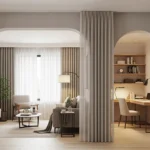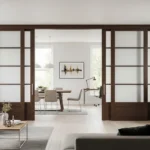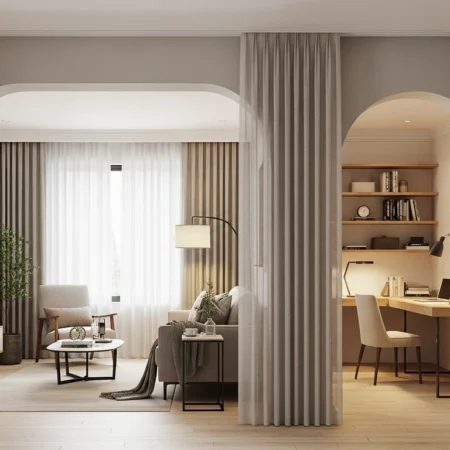Have you ever stood in your living room and thought, “I love this space… but I kind of need it to do two things at once”? You’re definitely not alone. I’ve had that moment myself — the one where the living room tries to be a home office, a place to unwind, and a backdrop for dinner with friends, all within the same four walls. That’s usually when the idea of a sliding door wall divider feels less like a design feature and more like a tiny miracle.
Sliding partitions let you shape your living room without shutting it down. They create privacy when you want it, openness when you need it, and a sense of intention that pulls everything together. And the best part? You can choose a style that feels like you — something practical, something beautiful, or something bold enough to declare, “Yes, this living room has personality.”
So if you’re ready to rethink your space in a way that’s both clever and genuinely enjoyable to live with, you’re in the right place.
1. Framed Glass Sliding Wall for an Airy Divide
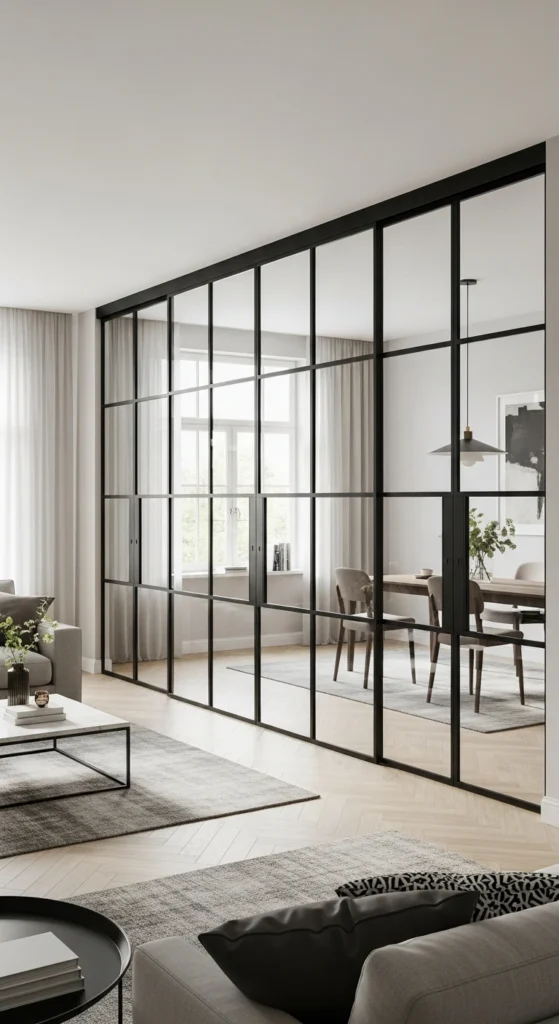
A framed glass sliding wall instantly lifts a living room by creating separation without sacrificing openness. The slim black lines add just enough structure to feel intentional while the clear glass keeps the whole space bright and connected. This style works beautifully in both small and large rooms, and it adds a subtle, modern elegance that never feels heavy. If you love the idea of zoning without boxing yourself in, this one delivers.
2. Frosted Glass Panels for Soft Privacy

Frosted glass sliding panels give you just the right amount of privacy without dimming your living room. They blur shapes and movement gently, so the room still feels calm and bright. This option works wonderfully when your living area sits next to a workspace or guest zone.
Why it works:
• Softly diffuses daylight for a relaxed atmosphere
• Adds privacy without visual heaviness
• Blends effortlessly with minimalist, modern, or Scandinavian interiors
3. Wooden Slat Sliding Screen for Warm Texture

Want separation without losing that warm, inviting vibe that makes a living room feel like home? A wooden slat sliding screen gives you that sweet spot. It filters light beautifully, adds natural texture, and instantly softens modern interiors. This style pairs effortlessly with cozy fabrics, plants, and neutral palettes, creating a relaxed zone that still feels open and breathable.
4. Barn-Style Sliding Doors for Rustic Charm
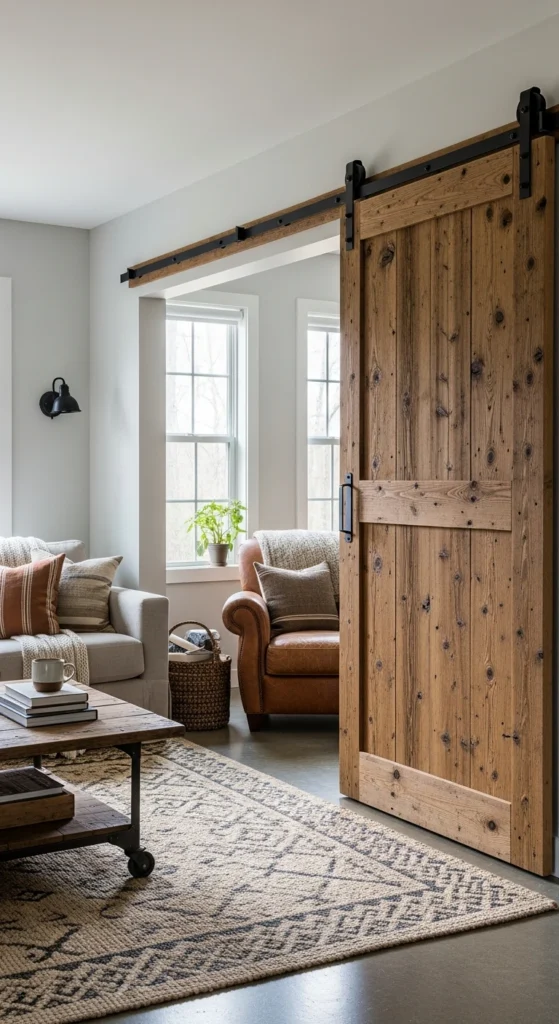
Barn-style sliding doors bring an easygoing, lived-in warmth to a living room, especially when you choose reclaimed or knotty wood. The exposed hardware adds a little drama without overwhelming the space, and the whole setup feels both sturdy and welcoming.
Quick steps:
- Pick a wood tone that complements your existing furniture.
- Install a strong, visible track for that signature farmhouse look.
- Add simple handles to keep the design relaxed and timeless.
5. Slim Metal Frame with Clear Glass for Industrial Edge

Unlike a solid wall that closes everything in, a slim metal-framed glass divider keeps your living room open while adding unmistakable industrial character. The clean lines and exposed metal bring a bit of urban grit without overwhelming the space. For instance, pairing this style with leather seating or a brick accent wall instantly gives the room that loft-like charm many people love.
6. Shoji-Style Sliding Panels for Calm Minimalism
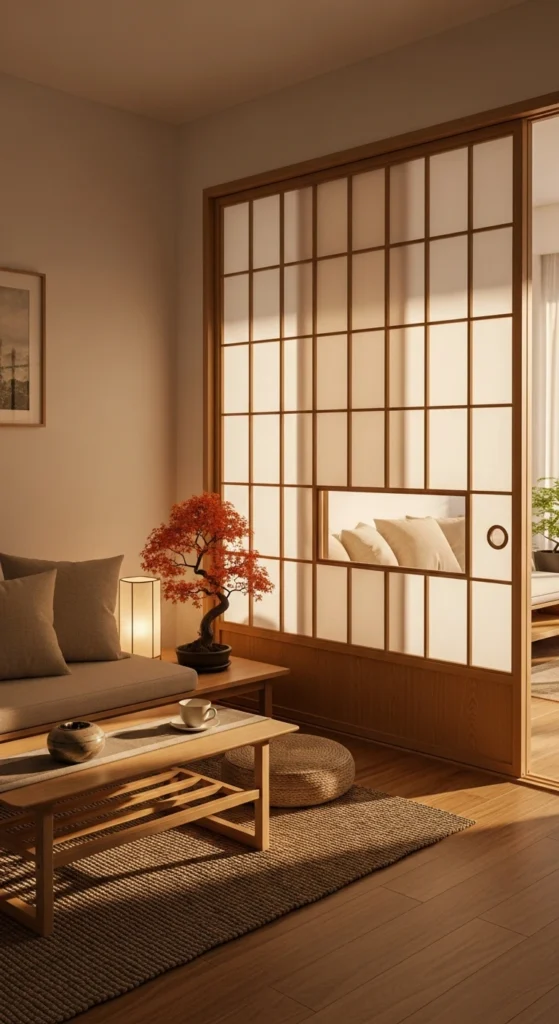
Shoji-inspired sliding panels instantly bring a sense of calm to a living room. Their soft, diffused light creates a serene atmosphere that feels effortless and soothing. The clean grid patterns and natural wood tones make them ideal for minimalist spaces or anyone craving a quieter, more grounded aesthetic.
Pro tip: Choose durable synthetic paper or fabric inserts if you want the traditional look without worrying about accidental bumps, pets, or enthusiastic kids testing the panels’ limits.
7. Sliding Bookshelf Wall for Storage and Separation
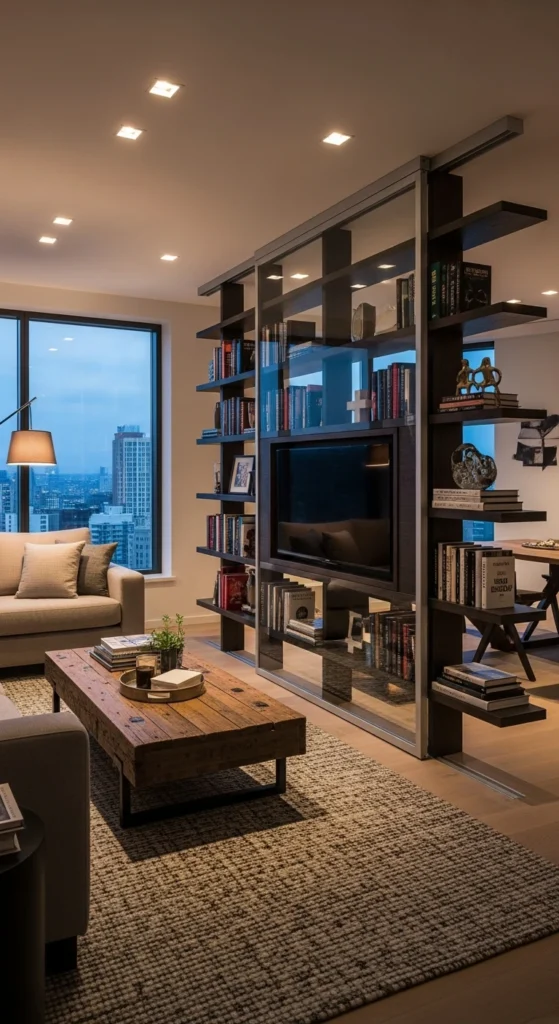
A sliding bookshelf divider earns its keep by doing two jobs at once: it stores your favourite books and decor while cleanly separating the living room from a study nook or dining area. The shelves look intentional from both sides, so the partition feels like a design feature rather than a barrier. When you glide it open, the room instantly becomes more social; when you close it, you get a cozy, private corner without sacrificing style.
8. Ceiling-Track Fabric Panels for a Soft, Flexible Divide
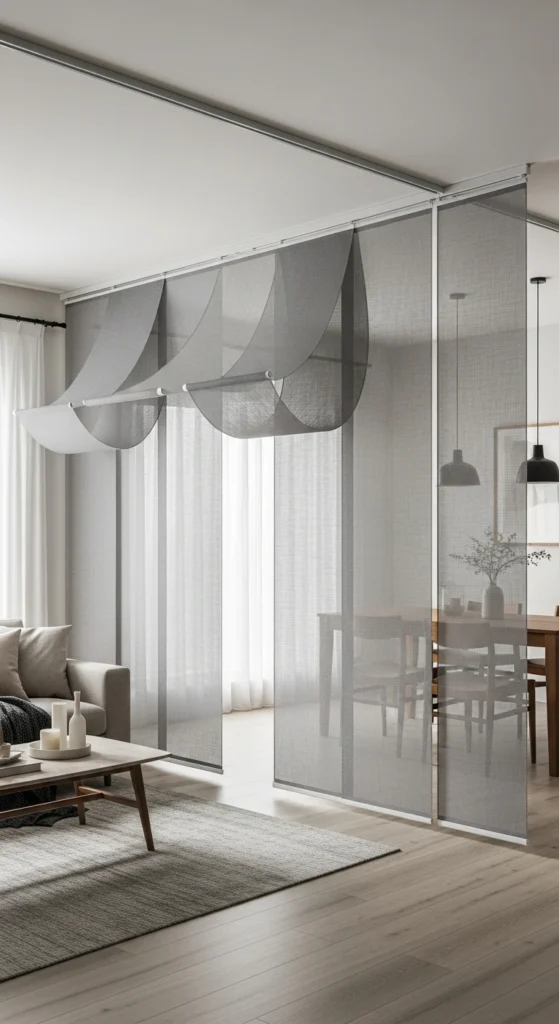
Ceiling-track fabric panels create an elegant, almost weightless partition that glides effortlessly when you need to shift the layout. They soften the room visually while also helping with acoustics, which makes them a smart option for open-plan living spaces. And when you slide them aside, the whole area opens up without fuss.
What makes it special:
• Minimal hardware keeps the look clean
• Fabric adds instant texture and warmth
• Easy to reconfigure for guests, work, or quiet evenings
9. Mirrored Sliding Doors to Brighten and Enlarge
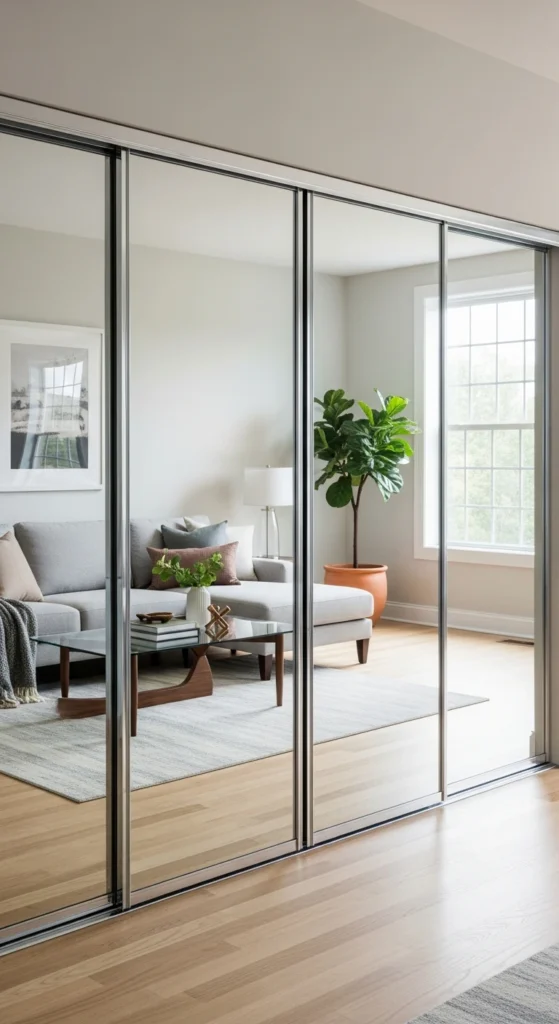
Wish your living room felt a little bigger without knocking down walls? Mirrored sliding doors pull off that illusion instantly by bouncing natural light around and visually expanding the space. They work especially well in narrower rooms or apartments that need a boost of brightness. To keep things stylish, choose slim frames or paneled mirror sections so the divider feels polished rather than overwhelming.
10. Pocket Sliding Partition That Disappears Completely

A pocket sliding partition gives you the best of both worlds: full separation when you need it and a completely open flow when you don’t. The door slides right into the wall cavity, leaving no visible panels or bulky hardware. It’s a clean, modern solution that makes a living room feel adaptable and uncluttered.
Quick guide:
- Plan the pocket cavity carefully—wiring and wall structure matter.
- Choose a solid, glass, or panelled door to suit your style.
- Use flush handles to keep the design sleek and seamless.
11. Acoustic Sliding Panels for Quiet Corners

Unlike simple glass partitions that mainly divide space visually, acoustic sliding panels actually help reduce noise between zones. They’re ideal when someone needs a calm corner for work while the rest of the household keeps moving. For example, thick wood-clad panels on a ceiling track can separate a TV area from a study nook, giving each person a little audio breathing room without sacrificing the open-plan feel.
12. Colour-Blocked Sliding Doors as a Design Feature

Colour-blocked sliding doors turn your partition into a bold, joyful statement. Instead of hiding the divider, you celebrate it, letting the colours tie together cushions, rugs, or artwork in the living room. It’s a brilliant choice if your space needs energy or personality—and yes, it makes guests smile the second they walk in.
What you’ll need:
• Flat or panelled sliding doors
• Paint or laminate in two to four coordinated colours
• Simple tracks that keep the focus on the artwork-like panels
How to Choose the Right Sliding Partition for Your Living Room
Choosing the right sliding partition starts with noticing how your living room actually works day to day. Do you need quiet for a home office corner? Do you want to nudge your dining area into a more defined space? Or do you simply love the idea of turning one big room into two whenever the mood strikes? Once you know your goal, the style becomes much easier to match.
Think first about light. Clear glass keeps things bright and open, while frosted or fabric panels offer privacy without making the room feel heavy. If you want real acoustic separation, thicker doors or insulated panels help take the edge off household noise. And if your living room tends to feel small, mirrored sliding panels can bounce light around beautifully.
Next, consider materials. Metal frames add sleek structure, wood brings warmth, and composite materials offer durability without much maintenance. Each one affects the room’s mood differently. Then look at the track system. Ceiling-mounted tracks create cleaner lines and avoid trip hazards, while floor tracks add stability for heavier panels.
Don’t forget practical details like kids, pets, or frequent guests. Soft-close hardware protects fingers (and sanity), while sturdy frames stand up to everyday life. And if you’ve got resale on the horizon, choose a neutral style that feels timeless. The right partition doesn’t just divide space — it supports how you live in it.
FAQ About Sliding Door Wall Dividers in Living Rooms
Are sliding door partitions safe for homes with kids and pets?
Yes — especially if you choose soft-close hardware and sturdy materials. Flush handles and tempered glass keep them even safer for curious hands.
Do sliding dividers work in small living rooms?
Absolutely. Clear or lightly frosted glass makes tight spaces feel bigger while still allowing you to define zones when needed.
How hard is it to maintain sliding door wall dividers?
Most options need just simple cleaning: wipe the panels, check the tracks occasionally, and tighten hardware if it ever loosens.
Conclusion
Sliding door wall dividers give your living room the power to shift, flex, and adapt exactly the way you need it to. Whether you lean toward cozy wood, airy glass, or something bold and colorful, the right design brings order and personality to your space. If one idea from this list sparked something for you, follow it — your living room might just be waiting for that perfect sliding moment.


